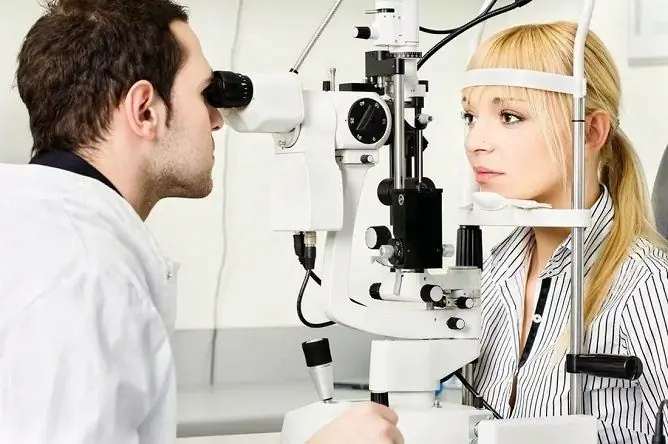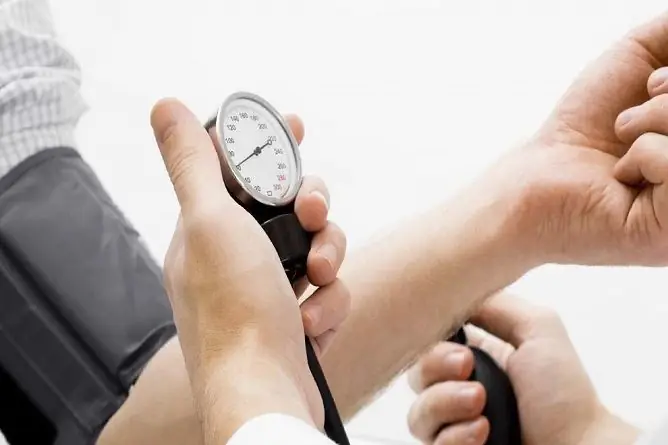- Author Rachel Wainwright [email protected].
- Public 2023-12-15 07:39.
- Last modified 2025-11-02 20:14.
Renal pressure: symptoms, causes, diagnosis and treatment
The content of the article:
- Renal pressure - what is it?
- Renal pressure: symptoms
- How to determine renal pressure
- How to lower kidney pressure
- Treatment
- Forecast
- Prevention
- Video
Renal pressure (nephrogenic arterial hypertension, renal hypertension, renal hypertension, renovascular hypertension) is a pathological condition in which the deviation of blood pressure from the norm occurs against a background of kidney disorders. In the absence of adequate therapy, cardiac or renal failure, impaired cerebral circulation, retinal hemorrhage, atherosclerotic lesions of blood vessels, and lipid metabolism may occur.

Renal hypertension requires treatment, first of all, renal pathology, pressure reduction alone is not enough
Nephrogenic arterial hypertension occurs in both adults and children.
Renal pressure - what is it?
There are several main mechanisms for the development of renal hypertension. First, with impaired renal function in the body, an increase in the volume of circulating blood and fluid retention occur. Secondly, excess sodium in the blood increases the sensitivity of the vascular wall to the action of hormones that increase the tone of blood vessels. Thirdly, the impetus to the development of nephrogenic hypertension gives a low level of prostaglandins and bradykinins (substances that contribute to a decrease in the tone of blood vessels) in the blood against the background of damage to the renal tissue.
All these factors lead to an increase in blood pressure, especially diastolic (lower), which is sometimes called renal for this reason.
Nephrogenic arterial hypertension is classified into three types:
- vasorenal - occurs against the background of vascular lesions, is often caused by fibromuscular stenosis (more often in women over 30 years old) or atherosclerotic stenosis of the renal artery (more often in men over 50 years old);
- parenchymal - develops in diseases characterized by damage to the kidney parenchyma (hydronephrosis, pyelonephritis, glomerulonephritis, kidney tuberculosis, diabetic glomerulosclerosis);
- mixed - appears when both blood vessels and renal tissue are damaged, which is observed in nephroptosis, benign or malignant neoplasms, as well as in the case of a combination of several processes that cause vasorenal and parenchymal forms.
In addition, blood pressure rises with prolonged renal colic.
Renal pressure: symptoms
The symptoms of nephrogenic hypertension are very similar to those of high heart pressure (cardiogenic hypertension). Often, with renal hypertension, there is an asymmetry of blood pressure on the right and left hand. In some cases, a pathological condition may not have any clinical signs for a long time.
Nephrogenic arterial hypertension manifests itself in two main groups of symptoms - high blood pressure and kidney damage.
The slow-flowing form of pathology is characterized by an increase in both systolic (upper) and diastolic (lower) pressure. At the same time, the patient has weakness, fatigue, headache, dizziness, a feeling of lack of air, tachycardia, chest discomfort.
With fast-flowing nephrogenic hypertension, high diastolic pressure is observed (up to 120 mm Hg and higher with a norm of 60-80 mm Hg) with normal or slightly elevated systolic pressure. This condition is manifested by a rapid increase in symptoms: headache localized in the occiput, nausea, vomiting, blurred vision, general deterioration in well-being, disorientation.

Renal hypertension is manifested not only by increased blood pressure, but also by lower back pain
For any form, pain in the lumbar region is characteristic, acute with fast-flowing nephrogenic hypertension, pulling - with slow-flowing. There may also be nosebleeds, confusion.
How to determine renal pressure
Renal hypertension can be suspected by a small difference between systolic and diastolic pressure, in this case it is less than 30 mm Hg. Art.
The following diagnostic methods are used:
- Ultrasound of the kidneys;
- ultrasound doppler angiography;
- extractorial urography;
- computed or magnetic resonance imaging of the kidneys.
In addition, laboratory tests of blood and urine are required. Renin, catecholamines (differential diagnosis with pheochromocytoma), aldosterone (if adrenal neoplasms are suspected) are being investigated. In the general analysis of urine, proteinuria, hypostenuria, hematuria can be detected.
Renal hypertension is characterized by murmurs in the projection of the renal arteries.
Retinal lesions more often occur with nephrogenic than with arterial hypertension of a different etiology. For this reason, patients are necessarily sent for an ophthalmological examination with an examination of the fundus.
How to lower kidney pressure
Having learned about the diagnosis, patients are looking for information on what to do, what to drink with this pathology. It should be borne in mind that it is impossible to try to treat nephrogenic arterial hypertension on your own - uncontrolled intake of pills with a high degree of probability will only aggravate the condition. Why and folk remedies can also be used only after consulting a doctor.
You can quickly relieve high blood pressure at home with the help of a foot compress made from table vinegar diluted with water in a 1: 1 ratio, but you need to understand that this is only a temporary relief of the condition, this procedure does not have a therapeutic effect and does not cancel the need for medical intervention.
It is also possible to bring down increased nephrogenic pressure with the help of antihypertensive drugs, however, prolonged symptomatic treatment without eliminating the etiological factor can lead to wrinkling of the kidney.
Treatment
Treatment of renal pressure is aimed at eliminating the underlying disease that caused it, so a nephrologist or urologist deals with it.
Drug therapy, depending on the indications, may include anti-inflammatory, antibacterial, antimycotic drugs. With hydronephrosis, antispasmodic, analgesic drugs, broad-spectrum antibacterial drugs, diuretics are indicated. Kidney tuberculosis requires active anti-tuberculosis therapy. With glomerulonephritis, direct renin inhibitors, angiotensin receptor blockers, and angiotensin-converting enzyme inhibitors are used.
Attention! Photo of shocking content.
Click on the link to view.
In some cases, surgical intervention is necessary: resection or prosthetics of the renal artery, balloon dilation. With nephroptosis, nephropexy is usually performed. In the case of damage to only one kidney and the ineffectiveness of the conservative treatment, the expediency of partial or complete nephrectomy may be considered. This operation will eliminate hypertension, which could otherwise damage the second kidney. If both kidneys are severely damaged, one of them may need to be transplanted.
Forecast
With timely and correctly selected treatment, the prognosis is favorable. It worsens in the case of rapid progression of the vasorenal form of the disease and in the absence of adequate treatment of any form, since irreversible changes occur in the renal tissue. With advanced parenchymal form and bilateral kidney damage, the prognosis is poor, which becomes conditionally favorable after kidney transplantation.
Prevention
In order to prevent the development of nephrogenic hypertension and its complications, it is recommended to correct excess weight, a diet with a restriction on the use of table salt, and rejection of bad habits. In the absence of contraindications, the patient should increase physical activity.
Video
We offer for viewing a video on the topic of the article.

Anna Aksenova Medical journalist About the author
Education: 2004-2007 "First Kiev Medical College" specialty "Laboratory Diagnostics".
Found a mistake in the text? Select it and press Ctrl + Enter.






